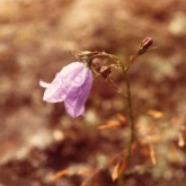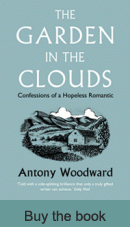Britain's most beautiful flower



BRITAIN'S MOST BEAUTIFUL FLOWER
|
Come July, one of the most striking wild flowers growing in profusion at Tair-Ffynnon is the harebell. Some summers, our Top Field shimmers blue like shot silk. This has particular significance for Antony because the harebell is my favourite flower. Partly this is because it’s one of the few I can confidently identify, but mainly it’s because the harebell has great symbolic significance for me. When I was five, my mother had an accident which confined her to a wheelchair for the rest of her life. It |
was a tough year adapting to our new circumstances, and the following summer we—my parents, my brother, the new wheelchair and I—took a family holiday to Scotland. The sun shone hard and bright every day, and the highland landscape seemed beyond sublime—perhaps because it was beyond reach. It seemed to represent everywhere my mother’s disability now denied us. This was the background to my harebell epiphany some years’ later … |
 I pleaded to return to Scotland. Eight years later we finally did, though this time just my parents and I (Jonny, my brother, now being too old for family holidays). I pleaded to return to Scotland. Eight years later we finally did, though this time just my parents and I (Jonny, my brother, now being too old for family holidays).
I was fifteen and toting a new camera. On this occasion the skies were less obliging. The clouds over the east coast and the Central Highlands were grey and low, and released a steady, set-in rain, day after day. The place I’d been dying to revisit for so long was dull, miserable and largely hidden. The hotels, selected as usual according to the presence, size and specification of their lifts, were gloomy and dispiriting. For a week that August we motored disconsolately around in a suffocating fug (the car heater roaring away at the default MAX setting specified by my mother), every mountain and view buried. Rain streamed down the outside of the car, condensation down the inside. After four days peering through the arc cleared by the windscreen wipers at the strip of road ahead, I had cabin fever as I’ve never known it before or since. Late morning of Day Five found us in dense mist on Ben Lawers in the Central Grampians. Needing a pee, at a convenient moment I was let out of the car. Clutching my new camera, I followed a burn a little way up the hill into the murk, gratefully gulping the saturated air. It felt marvelous to be stretching my legs. Sprinkled among the sodden tussocks were tiny blue flowers a few inches tall, their bell heads suspended from hair-like stalks, flashes of pure colour in that grey-green landscape. Their heads never rested, nodding and quivering with every breath of wind. Their timid loveliness seemed too fragile, somehow, for this bleak place. |
With the car out-of-sight in the mist, its gravitational pull lessened. I decided to follow the burn a bit further up. As I plodded through the mist, feet now soaking, it grew rockier underfoot, slabs of dark, shining stone appearing through the springy turf. I’d gone about as far as I thought I should when, unexpectedly, the mist swept back, revealing, in front of me, a shallow pool. Here, after negotiating a step in the rock, the brown waters of the rushing burn were momentarily checked. It was a perfect natural rockery. Delicate ferns sprouted amongst the clumps of heather, laden with purple flowers. In the brightness, beads of rainwater gleamed on the heads of the harebells.
Here, finally, was the Scotland I’d come to see. It was my first close encounter, alone, with a truly wild place, and the intimacy and secrecy of the moment took me by surprise. Though there was more to it than that. The experience also had the thrill of being stolen, of rebellion against and truancy from the car and all it stood for. I just had time to snap a photograph before the mist closed back in.
Chapter 13, The Accident

Ben Lawers, 1978
|
